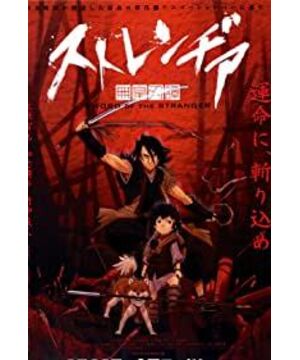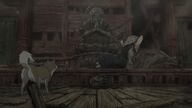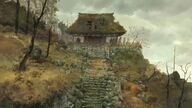Undoubtedly, the action scenes here fully implement the concept of "animation". The Bone Club has always produced excellent action works. This work can be said to be created by the gathering of great people and the strongest strength of everyone.
Because of this animation, I checked the list of BONES works carefully for the first time, and found that this club is really quite individual. Every famous work has its own points that I want to focus on depicting. I have to admit that The only thing is that the plot is a little weaker, and the ending is often unfinished, but most of the other places really have nowhere to pick shortcomings.
Unexpectedly, Steelmaking and Cowboy Bebop are both made by Bone Club. I especially like Cowboy's style, it's really cool, it's smooth, it's really artistic.
Bones are not like some animations that are just perfunctory, outsourced to overseas, and then make money crazy.
The birth of this Bladeless Blade Tan proves this.
Director Masahiro Ando wanted to depict the spark of martial arts produced by the confrontation between Chinese martial arts and Japanese swordsmanship. It was a smart decision to choose two "foreigners", so that everyone would not have to start from the root.
However, after the movie was released, it was an upset, a work that had been sharpening a sword for five years, and it fell into a low ebb in Japan.
Although he was nominated for an Oscar, he was only applauded. BONES lost a lot of cost, and it has been back for five years, and I don't know if it will come back.
Too much backbone.
Directors from all walks of life have praised Director Itan's spirit of not following the crowd and doing what he wants to do with his heart.
Just last winter, it was a snowy day, and I read this work for the first time.
Deeply in love, unable to extricate themselves, the attraction of good things is always lasting. I don't want to say that fighting drama is "textbook-like", it feels like a complete loss of beauty and creativity. Why I like animation is because animation can draw a world that can't be photographed normally, and everyone's world is different. , so everyone's paintings are different.
The style of Bladeless Blade Tan is serious, rigorous, and pathetic.
In addition to the excellent painting, the music is another highlight of this work. The composer is Naoki Sato. I also read this to check the information, only to know that he has done X-Men, Rurouni Kenshin, and even Dora The music that a dream accompanies me is also his single-handed achievement.
The most wonderful music is when Luo Lang and Wuming fought to the death, "The Sword of the Alien", the majestic, majestic, one-stop, and the determination to fight to the death, in the snowy night in the play, rendered Just right, very contagious.
I like the Chinese music made by such foreigners, one is Naoki Sato's style, and the other is Hans Zimmer, who has made music of Kung Fu Panda.
Compared with the two, they are really Japanese and Western styles, and they are different. In my opinion, Hans's music may more capture Chinese classical music. The music fluctuates up and down, but the orchestration and chords are still quite Western. happy. Another point is that his Chinese music has American optimism. In his music, there are many elements mixed with different tones, but Hans combines them very well. Of course, it is also because of the plot, the sad melody listens to There is also hope.
In this piece of music by Naoki Sato, the orchestration also uses a Chinese flute, but the effect is different. Although the interpretation of the flute is far-reaching and touching, the melody still has a strong Japanese style. I heard it from here. The Japanese-style desperate spirit is very methodical, the tonal fluctuations are well grasped, the styles of treble and bass are not much different, and the music is mixed into a whole. It's like drinking very strong tea with a long aftertaste.
Not only the music and painting support this work, some people may think that the plot is not good, but I think that the plot setting has basically the ability to tell the story well, and I think most of the characters in it are very successful. As an example, take the subordinate of the knotweed, Shigetaro, who obviously did not have a few words, but in the BGM "Snow of Redemption", what he said when he rode side by side with the knotweed to Shishiyin showed his loyalty vividly.
Knotta: "Is there any problem?" Chongtaro: "
You brought me and xx, I think there should be no problem!"
Knotta: "Then please!"
Chongtaro: "Please leave it to me!"
Then he gave Shiutaro a firm look.
Although this passage is about the rebellion of the knotweed, but the trust they showed in this passage deeply moved me.
Speaking of Luo Lang again, he is really a match for Wuming's character.
Every time I see them going to fight, I think you should stop fighting and live in seclusion in the mountains and learn from each other every day. However, Luo Lang is a martial idiot. I think his lifelong wish is to meet someone who has the same strength as him, and then learn from each other and enjoy the battle, even if he will die under the opponent's sword.
In the final battle, a close-up of the eyes of the two was specially given. Both of them fought for their own wishes. Luo Lang's wish was more Japanese-style, just simply enjoying the battle to the death, and Wuming why did he fight with Luo The wolf fights because he wants to live with Zai Taro, he must save Zai Taro, and saving this child is a kind of redemption for his cowardice in the past, and the only way for his mind to finally regain peace.
Luo Lang lived in order to die, and to live without a name.
Since the title of the work is called "No Emperor Blade Tan", does it mean that there is no winner?
In the last battle, the director repeatedly emphasized that the two are of equal level, and it actually depends on who is lucky. Obviously it is Wuming. At the beginning of the film, Feimaru blocks the darts for him, and it can be seen that Wuming's luck is really good, and it was brought to him by Zaitarou.
Many people are discussing whether Wuming is dead or alive in the end, but I have no answer.
To borrow a sentence from a netizen: "Not dead is luck, dead is a masterpiece."
Whether it is dead or alive, there will be people who implement Wuming's spirit and will remember Wuming.
Soldiers bear too many lives, and sometimes death is the only relief.
Not to mention a person called "Red Ghost".
I think that he has been redeemed in his soul, and generally those who are redeemed will go to meet God.
I know Wuming still wants to live and start a new life.
But every end is a beginning.
So this is the end of the matter, living or dying, it doesn't matter. The important thing is that hard work has really brought redemption. Wuming should be more relieved than anyone else.
All in all, whether it is Wuming or Luo Lang, they are all unparalleled in the world.
For each other, perhaps in the human world, they cannot coexist. The master can only keep one, and there is no room for two tigers in one mountain. When we really met, the masters’ conversations were all about understanding each other through tricks. Wuming looked at Luo Lang’s corpse silently after his death. Maybe he was remembering the battle just now. Through his performance, he was imagining what he was like. people.
I hope they can continue to learn martial arts, otherwise the days in heaven will be too lonely.
This work itself is unparalleled in the world.
Thank you to all the STAFFs who worked on this work, everyone, for bringing us true art, and eternal spirit.
View more about Sword of the Stranger reviews










